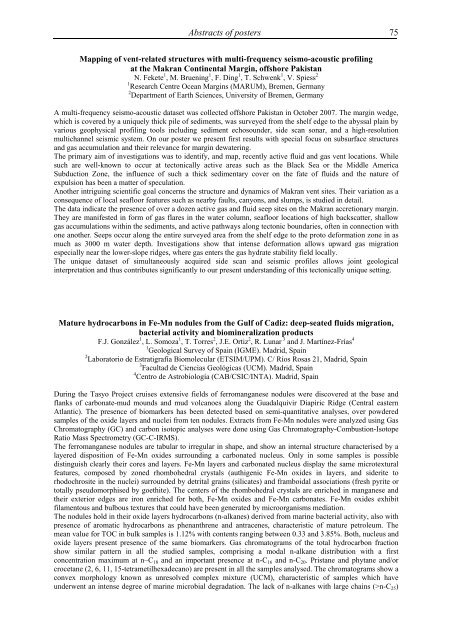Ninth international conference on - Marum
Ninth international conference on - Marum
Ninth international conference on - Marum
You also want an ePaper? Increase the reach of your titles
YUMPU automatically turns print PDFs into web optimized ePapers that Google loves.
Abstracts of posters 75<br />
Mapping of vent-related structures with multi-frequency seismo-acoustic profiling<br />
at the Makran C<strong>on</strong>tinental Margin, offshore Pakistan<br />
N. Fekete 1 , M. Bruening 1 , F. Ding 1 , T. Schwenk 1 , V. Spiess 2<br />
1 Research Centre Ocean Margins (MARUM), Bremen, Germany<br />
2 Department of Earth Sciences, University of Bremen, Germany<br />
A multi-frequency seismo-acoustic dataset was collected offshore Pakistan in October 2007. The margin wedge,<br />
which is covered by a uniquely thick pile of sediments, was surveyed from the shelf edge to the abyssal plain by<br />
various geophysical profiling tools including sediment echosounder, side scan s<strong>on</strong>ar, and a high-resoluti<strong>on</strong><br />
multichannel seismic system. On our poster we present first results with special focus <strong>on</strong> subsurface structures<br />
and gas accumulati<strong>on</strong> and their relevance for margin dewatering.<br />
The primary aim of investigati<strong>on</strong>s was to identify, and map, recently active fluid and gas vent locati<strong>on</strong>s. While<br />
such are well-known to occur at tect<strong>on</strong>ically active areas such as the Black Sea or the Middle America<br />
Subducti<strong>on</strong> Z<strong>on</strong>e, the influence of such a thick sedimentary cover <strong>on</strong> the fate of fluids and the nature of<br />
expulsi<strong>on</strong> has been a matter of speculati<strong>on</strong>.<br />
Another intriguing scientific goal c<strong>on</strong>cerns the structure and dynamics of Makran vent sites. Their variati<strong>on</strong> as a<br />
c<strong>on</strong>sequence of local seafloor features such as nearby faults, cany<strong>on</strong>s, and slumps, is studied in detail.<br />
The data indicate the presence of over a dozen active gas and fluid seep sites <strong>on</strong> the Makran accreti<strong>on</strong>ary margin.<br />
They are manifested in form of gas flares in the water column, seafloor locati<strong>on</strong>s of high backscatter, shallow<br />
gas accumulati<strong>on</strong>s within the sediments, and active pathways al<strong>on</strong>g tect<strong>on</strong>ic boundaries, often in c<strong>on</strong>necti<strong>on</strong> with<br />
<strong>on</strong>e another. Seeps occur al<strong>on</strong>g the entire surveyed area from the shelf edge to the proto deformati<strong>on</strong> z<strong>on</strong>e in as<br />
much as 3000 m water depth. Investigati<strong>on</strong>s show that intense deformati<strong>on</strong> allows upward gas migrati<strong>on</strong><br />
especially near the lower-slope ridges, where gas enters the gas hydrate stability field locally.<br />
The unique dataset of simultaneously acquired side scan and seismic profiles allows joint geological<br />
interpretati<strong>on</strong> and thus c<strong>on</strong>tributes significantly to our present understanding of this tect<strong>on</strong>ically unique setting.<br />
Mature hydrocarb<strong>on</strong>s in Fe-Mn nodules from the Gulf of Cadiz: deep-seated fluids migrati<strong>on</strong>,<br />
bacterial activity and biomineralizati<strong>on</strong> products<br />
F.J. G<strong>on</strong>zález 1 , L. Somoza 1 , T. Torres 2 , J.E. Ortiz 2 , R. Lunar 3 and J. Martínez-Frías 4<br />
1 Geological Survey of Spain (IGME). Madrid, Spain<br />
2 Laboratorio de Estratigrafía Biomolecular (ETSIM/UPM). C/ Ríos Rosas 21, Madrid, Spain<br />
3 Facultad de Ciencias Geológicas (UCM). Madrid, Spain<br />
4 Centro de Astrobiología (CAB/CSIC/INTA). Madrid, Spain<br />
During the Tasyo Project cruises extensive fields of ferromanganese nodules were discovered at the base and<br />
flanks of carb<strong>on</strong>ate-mud mounds and mud volcanoes al<strong>on</strong>g the Guadalquivir Diapiric Ridge (Central eastern<br />
Atlantic). The presence of biomarkers has been detected based <strong>on</strong> semi-quantitative analyses, over powdered<br />
samples of the oxide layers and nuclei from ten nodules. Extracts from Fe-Mn nodules were analyzed using Gas<br />
Chromatography (GC) and carb<strong>on</strong> isotopic analyses were d<strong>on</strong>e using Gas Chromatography-Combusti<strong>on</strong>-Isotope<br />
Ratio Mass Spectrometry (GC-C-IRMS).<br />
The ferromanganese nodules are tabular to irregular in shape, and show an internal structure characterised by a<br />
layered dispositi<strong>on</strong> of Fe-Mn oxides surrounding a carb<strong>on</strong>ated nucleus. Only in some samples is possible<br />
distinguish clearly their cores and layers. Fe-Mn layers and carb<strong>on</strong>ated nucleus display the same microtextural<br />
features, composed by z<strong>on</strong>ed rhombohedral crystals (authigenic Fe-Mn oxides in layers, and siderite to<br />
rhodochrosite in the nuclei) surrounded by detrital grains (silicates) and framboidal associati<strong>on</strong>s (fresh pyrite or<br />
totally pseudomorphised by goethite). The centers of the rhombohedral crystals are enriched in manganese and<br />
their exterior edges are ir<strong>on</strong> enriched for both, Fe-Mn oxides and Fe-Mn carb<strong>on</strong>ates. Fe-Mn oxides exhibit<br />
filamentous and bulbous textures that could have been generated by microorganisms mediati<strong>on</strong>.<br />
The nodules hold in their oxide layers hydrocarb<strong>on</strong>s (n-alkanes) derived from marine bacterial activity, also with<br />
presence of aromatic hydrocarb<strong>on</strong>s as phenanthrene and antracenes, characteristic of mature petroleum. The<br />
mean value for TOC in bulk samples is 1.12% with c<strong>on</strong>tents ranging between 0.33 and 3.85%. Both, nucleus and<br />
oxide layers present presence of the same biomarkers. Gas chromatograms of the total hydrocarb<strong>on</strong> fracti<strong>on</strong><br />
show similar pattern in all the studied samples, comprising a modal n-alkane distributi<strong>on</strong> with a first<br />
c<strong>on</strong>centrati<strong>on</strong> maximum at n–C18 and an important presence at n-C16 and n-C20. Pristane and phytane and/or<br />
crocetane (2, 6, 11, 15-tetrametilhexadecano) are present in all the samples analysed. The chromatograms show a<br />
c<strong>on</strong>vex morphology known as unresolved complex mixture (UCM), characteristic of samples which have<br />
underwent an intense degree of marine microbial degradati<strong>on</strong>. The lack of n-alkanes with large chains (>n-C25)














